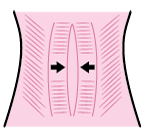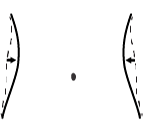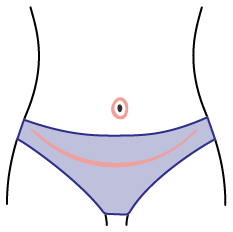
Tummy Tuck
What is a Tummy Tuck?
Abdominoplasties or “tummy tucks” are one of the most popular and frequently performed cosmetic surgeries. It is the best way to address excess lower abdominal skin and loosening of the abdominal wall that cannot be addressed with diet and exercise alone.
An abdominoplasty addresses:
- Excess or folded skin
- Stretch marks
- Abdominal muscle bulging
- Rectus diastasis

What Happened to My Skin and Muscles?
During pregnancy or weight gain, the skin is stretched to accommodate inflation from the added mass. At the limits of stretching, the skin changes irreversibly. “Stretch marks” reflect deeper skin tears and scar tissue as the body repairs the tear. When weight is lost, the skin’s ability to rebound is limited. These changes result in the appearance of folded and excess skin in the lower abdomen.
In the abdominal muscle layers, the fibrous sheet between the rectus (“six-pack”) muscles separate with added pressure from deep in the abdomen. Although exercise can help strengthen the muscle, the stretched sheet will not tighten again. This results in the feeling of a looser abdominal wall, or bulging, noted on exercise.
What Is an Abdominoplasty?
An abdominoplasty is a cosmetic body contouring surgery that addresses the abdominal shape in multiple layers, to provide a balanced and long-lasting appearance. This is achieved by addressing:
Skin

The extra folds of skin are pulled down and trimmed in the lower abdomen, near the underwear line.
Muscle

The loose tissue between the muscles are tightened and pleated to improve the deeper support.
Fat

Extra fat is trimmed or removed with liposuction to tailor the contour at the sides.
An abdominoplasty lasts approximately 4 hours. Most people go home the day of surgery. If needed, you may stay at the hospital overnight. You will wake up with dressings, and possibly drains. An abdominal binder is placed to hold your shape and will be needed for the next 8 weeks. You will receive aftercare instructions and medication to control pain and sensitivity.
Who Can Have an Abdominoplasty?

Abdominoplasty works best to contour loose skin and muscles. This is not a substitute for weight loss. The best outcome for surgery occurs when a patient has good general health, has reasonable expectations, does not smoke cigarettes, and has a stable weight (BMI under 30). Other special considerations include past abdominal surgeries, the presence of hernias, or gastric bypass procedures.
Preparing for Surgery
You will have a pre-operative appointment with your surgeon, where you have an opportunity to review the plan and ask questions. You may need some tests before surgery to review your iron levels and possibly the presence of hernias.
To maximize your ability to recover, we recommend improving your protein intake. Blood thinners need to be stopped safely (including aspirin). We will provide a list of food and supplements to avoid before surgery.
Recovery After Surgery
The usual recovery time is 4 weeks after surgery. During this time, you will have swelling, bruising, and tenderness. The swelling peaks in the 3-4 days after surgery. The muscle may feel very tight, similar to a heavy workout. Occasional twinges can be felt with movement at the areas where the muscle was tightened which will decrease over time. If there is pressure to the lower back from bending over, we recommend renting a walker to help relieve the pain during this time. You will need to wear the binder for 8 weeks. We recommend no exercise during this period for best results.
There is a small amount of lingering swelling that can last for 3-6 months. The internal scarring softens and changes over a 1 year period when the result is stable. The final result is after 1 year.

Book a Consultation
Schedule your personal consultation with Dr. Lee to talk about Tummy Tuck surgery.
Discover the Possibilities by Viewing Our Before and After Gallery

